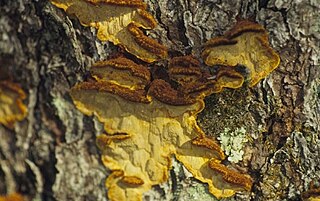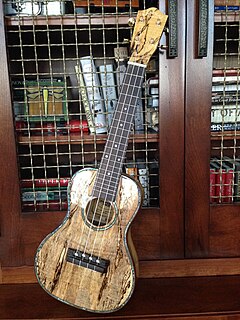
Armillaria is a genus of fungi that includes the A. mellea species known as honey fungi that live on trees and woody shrubs. It includes about 10 species formerly categorized summarily as A. mellea. Armillarias are long-lived and form some of the largest living organisms in the world. The largest known organism covers more than 3.4 square miles (8.8 km2) in Oregon's Malheur National Forest and is more than 2,400 years old. Some species of Armillaria display bioluminescence, resulting in foxfire.

Dry rot is wood decay caused by certain species of fungi that digest parts of the wood which give the wood strength and stiffness. It was previously used to describe any decay of cured wood in ships and buildings by a fungus which resulted in a darkly colored deteriorated and cracked condition.

Uncinula necator is a fungus that causes powdery mildew of grape. It is a common pathogen of Vitis species, including the wine grape, Vitis vinifera. The fungus is believed to have originated in North America. European varieties of Vitis vinifera are more or less susceptible to this fungus. Uncinula necator infects all green tissue on the grapevine, including leaves and young berries. It can cause crop loss and poor wine quality if untreated. The sexual stage of this pathogen requires free moisture to release ascospores from its cleistothecia in the spring. However, free moisture is not needed for secondary spread via conidia; high atmospheric humidity is sufficient. Its anamorph is called Oidium tuckeri.

Rhizoctonia solani is a plant pathogenic fungus with a wide host range and worldwide distribution. It was discovered more than 100 years ago. R. solani frequently exists as thread-like growth on plants or in culture, and is considered a soil-borne pathogen. R. solani is best known to cause various plant diseases such as collar rot, root rot, damping off, and wire stem. R. solani attacks its hosts when they are in their early stages of development, such as seeds and seedlings, which are typically found in the soil. The pathogen is known to cause serious plant losses by attacking primarily the roots and lower stems of plants. Although it has a wide range of hosts, its main targets are herbaceous plants. R. solani is a basidiomycete fungus but the teleomorph stage is not prominent. Occasionally, sexual spores (basidiospores) are produced on infected plants. The disease cycle of R. solani is important in management and control of the pathogen. The pathogen is not currently known to produce any asexual spores (conidia), though it is considered to have an asexual lifecycle perpetuated through sclerotia.

A wood-decay or xylophagous fungus is any species of fungus that digests moist wood, causing it to rot. Some species of wood-decay fungi attack dead wood, such as brown rot, and some, such as Armillaria, are parasitic and colonize living trees. Excessive moisture above the fibre saturation point in wood is required for fungal colonization and proliferation. Fungi that not only grow on wood but permeate its fibrous structure and actually cause decay, are called lignicolous fungi. In nature, this process causes the breakdown of complex molecules and leads to the return of nutrients to the soil. Various lignicolous fungi consume wood in various ways; for example, some attack the carbohydrates in wood and some others decay lignin. The rate of decay of wooden materials in various climates can be estimated by empirical models.

Sclerotinia sclerotiorum is a plant pathogenic fungus and can cause a disease called white mold if conditions are conducive. S. sclerotiorum can also be known as cottony rot, watery soft rot, stem rot, drop, crown rot and blossom blight. A key characteristic of this pathogen is its ability to produce black resting structures known as sclerotia and white fuzzy growths of mycelium on the plant it infects. These sclerotia give rise to a fruiting body in the spring that produces spores in a sac which is why fungi in this class are called sac fungi (Ascomycetes). This pathogen can occur on many continents and has a wide host range of plants. When S. sclerotiorum is onset in the field by favorable environmental conditions, losses can be great and control measures should be considered.
Bipolaris cactivora is a plant pathogen causing cactus stem rot and pitaya fruit rot.

Phellinus pini is a fungal plant pathogen that causes tree disease commonly known as "red ring rot" or "white speck". This disease, extremely common in the conifers of North America, decays tree trunks, rendering them useless for lumber. It is a rot of the heartwood. Signs of the fungus include shelf-shaped conks protruding from the trunks of trees. Spores produced on these conks are blown by the wind and go on to infect other trees. Formal management of this disease is limited, and the disease is controlled primarily by cultural practices. Red ring rot is an important forest disturbance agent and plays a key role in habitat formation for several forest animals.
Phialophora gregata is a Deuteromycete fungus that is a plant pathogen which causes the disease commonly known as "brown stem rot of soybean. P. gregata does not produce survival structures, but has the ability to overwinter as mycelium in decaying soybean residue.

Spalting is any form of wood coloration caused by fungi. Although primarily found in dead trees, spalting can also occur in living trees under stress. Although spalting can cause weight loss and strength loss in the wood, the unique coloration and patterns of spalted wood are sought by woodworkers.

Laminated root rot also known as yellow ring rot is caused by the fungal pathogen Phellinus weirii. Laminated root rot is one of the most damaging root disease amongst conifers in northwestern America and true firs, Douglas-fir, Mountain hemlock, and Western hemlock are highly susceptible to infection with P. weirii. A few species of plants such as Western white pine and Lodgepole pine are tolerant to the pathogen while Ponderosa pine is resistant to it. Only hardwoods are known to be immune to the pathogen.

Rhizina undulata, commonly known as the doughnut fungus or the pine firefungus, is a species of fungus in the family Rhizinaceae. The fruit bodies of the fungus are dark purple brown with a bright yellow margin, crust-like and attached to the growing surface by numerous root-like yellow rhizoids. R. undulata has a cosmopolitan distribution, and commonly occurs on clearings or burned areas throughout central and northern Europe, North America, northern Asia, and southern Africa. It is parasitic on conifer seedlings, and has caused considerable damage to tree plantations worldwide.
Armillaria novae-zelandiae is a species of mushroom in the family Physalacriaceae. This plant pathogen species is one of three Armillaria species that have been identified in New Zealand.

Fomes fomentarius is a species of fungal plant pathogen found in Europe, Asia, Africa and North America. The species produces very large polypore fruit bodies which are shaped like a horse's hoof and vary in colour from a silvery grey to almost black, though they are normally brown. It grows on the side of various species of tree, which it infects through broken bark, causing rot. The species typically continues to live on trees long after they have died, changing from a parasite to a decomposer.

The Nidulariaceae are a family of fungi in the order Agaricales. Commonly known as the bird's nest fungi, their fruiting bodies resemble tiny egg-filled birds' nests. As they are saprobic, feeding on decomposing organic matter, they are often seen growing on decaying wood and in soils enriched with wood chips or bark mulch; they have a widespread distribution in most ecological regions. The five genera within the family, namely, Crucibulum, Cyathus, Mycocalia, Nidula, and Nidularia, are distinguished from each other by differences in morphology and peridiole structure; more recently, phylogenetic analysis and comparison of DNA sequences is guiding new decisions in the taxonomic organization of this family.

The sirex woodwasp is a species of horntail, native to Europe, Asia, and northern Africa. Adults vary in length from 9 to 36 mm.
Stromatinia cepivora is a fungus in the division Ascomycota. It is the teleomorph of Sclerotium cepivorum, the cause of white rot in onions, garlic, and leeks. The infective sclerotia remain viable in the soil for many years and are stimulated to germinate by the presence of a susceptible crop.
Fibroporia bohemica is a species of poroid crust fungus in the family Fomitopsidaceae.

Mariannaea elegans an anamorphic fungus. It is mainly found on rotting wood and soil. M. elegans is not pathogenic to humans, animals, or plants.

Phialophora fastigiata is a mitosporic, saprophytic fungus commonly found in soil, and on wood, and wood-pulp. This species was initially placed in the genus Cadophora but was later transferred to the genus Phialophora based on morphological and growth characteristics. In culture, P. fastigiata produces olive-brown, velvety colonies. The fungus is recognizable microscopically due to the presence of distinctive, funnel-shaped cuffs (collarettes) encircling the tips of phialides that bear slimy conidia. The fungus is often implicated in soft-rot wood decay due to its ability to degrade lignin, cellulose and pectin. It has also been reported to cause blue staining of wood and wood pulp.















